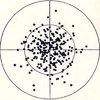Most of the comments on forums are based on limited personal experience and interpreted by amateur scientists and mathematicians (myself included). Misapplying dynamic laws of physics, injecting false assumptions as facts, flat out false claims, etc., is the norm.
For some semi-automatic rifles it's almost impossible to estimate chamber pressure using the standard processes used with a bolt action rifle, by the time you see all that case damage it's too late. I'm not saying that you shouldn't be familiar with the signs of excessive pressure but I am saying that none of these signs are conclusive. Many factors can effect what you see and the simple fact that the yield strength of cartridge brass can vary quite a lot (with a common yield value of around 65,000 PSI), means that you could either be mislead in to believing that an extrusion mark indicated too high of pressure when in fact it wasn't or not see the same extrusion mark until you've exceeded the SAAMI max pressure for your chambering, it's so variable that I wouldn't really depend on that test for any kind of consistency across the board. On the other hand, if you know your firearm very well and you've already proven (through other processes) that extrusion marks indicate a specific pressure limit has been reached then by all means, continue to use that as a valid field expedient. But if you're just starting out then it's just a guess as to what kinds of pressures you're working with. Primers can move because of a worn primer pocket, even with a proper powder charge. Primer cups can flatten differently to the same pressure depending on any coating or wash that was applied by the manufacturer or slight dimensional differences of the firearm. Primer cups are normally made from cartridge brass so the same problems with extrusion applies as mentioned above. Primer sizes (small, large, pistol, rifle) will change how the same pressure effects the look of the fired primer cup. Primers are just another unreliable test that is only reliable if you have proven through some other process that a specific feature indicates that a certain pressure limit with a specific firearm has been reached. But that's very individualistic and each of us have to come up with our own standard for each of our weapons.
The only way I feel fairly assured of a safe powder load is to stay within factory recommended powder charges and no, lawyers haven't forced Hornady to produce light load recommendations. Powder manufacturers are not the best source of load data, bullet manufacturers are. The guys that produce the bullets usually provide detailed cartridge and test data when they recommend a powder charge along with what specific bullet they used. Powder manufacturers usually provide minimal information about the cartridge, they simply want to tell you how much of their powder you should use. I also use QuickLoad to help develop cartridges but again, it's all about the details, you have to understand a little more than the average shooter about the physics and mathematics involved and you have to be very precise with the inputs. With QuickLoad just knowing that the estimated max pressure is within SAAMI standards isn't enough to tell if the load is safe.


